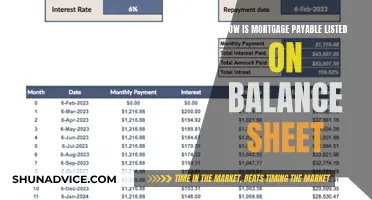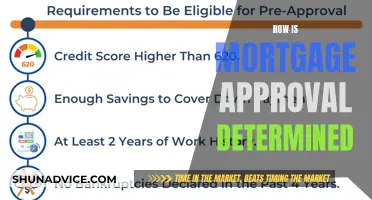
The mortgage industry is a major financial sector in the United States, with the federal government creating programs to encourage mortgage lending, construction, and home ownership. Mortgage companies are financial firms that offer a range of mortgage products, including fixed-rate, adjustable-rate, and refinance options, to potential homebuyers. The mortgage market is divided into the primary market, where home loans originate, and the secondary market, where loans are sold to investors. Mortgage rates tend to be influenced by the performance of the wider economy, with rates typically increasing during periods of economic growth and decreasing during recessions. In recent years, the industry has faced challenges due to the subprime mortgage crisis and the COVID-19 pandemic, leading to fluctuations in mortgage rates and lending practices.
| Characteristics | Values |
|---|---|
| Overall outlook | Pessimism due to anticipated recessionary conditions, inflation, and shrinking mortgage demand. However, there is optimism within the mortgage technology segment. |
| Mortgage rates | Expected to move lower over the course of the year, potentially reaching the 5% range. |
| Mortgage applications | Plummeted to the lowest in nearly three decades due to high-interest rates. |
| Mortgage defaults | Expected to increase in 2023 and 2024 due to rising delinquencies. |
| Regulatory updates | New capital rules, Basel III Endgame, proposed by the Federal Deposit Insurance Company (FDIC), the Federal Reserve, and the Office of the Controller of the Currency (OCC) will impact banks with over $100 billion in assets. |
| Technology | Investment in mortgage technology remains a priority, with many lenders adopting AI and modernizing front-end platforms, workflow management, and document management. |
| Competition | Increased competition from individual mortgage brokers who work with multiple lenders. |
| Home equity lending | Placed focus on home equity lending as a way to demonstrate a customer-first mentality and build repeat customer business. |
What You'll Learn

The mortgage market
The primary market is the domain of lenders who directly originate mortgages for consumers. These lenders include mortgage companies, mortgage bankers, and commercial banks. Mortgage companies, as specialised financial firms, focus exclusively on mortgage products and act as direct lenders. They market themselves to borrowers and obtain funding from financial institutions to provide capital for the loans. Mortgage bankers and commercial banks, on the other hand, offer a broader range of financial services beyond mortgages. In the primary market, borrowers approach these lenders to secure financing for their home purchases. This process involves providing financial information, employment history, credit history, and details about the intended property. Lenders then assess the borrower's ability to repay through a rigorous underwriting process before approving the loan.
The secondary market, in contrast, involves the sale of mortgages by primary market lenders to institutional investors. This allows primary lenders to recover their capital and continue lending. The secondary market investors, such as Fannie Mae and Freddie Mac, package the purchased mortgages into mortgage-backed securities (MBS). These MBS are then sold to third-party investors, including hedge funds, investment banks, and pension funds. This secondary market activity provides a continuous flow of funding back into the primary market, enabling lenders to make more loans without waiting for lengthy repayment periods from borrowers.
Mortgages: Put Option-Like Security for Homeowners
You may want to see also

Mortgage companies
The US mortgage industry has faced a challenging environment in 2023, with a combination of economic factors influencing the market.
However, there are also reasons for optimism within the industry. For instance, mortgage rates for 30-year fixed loans have shown a downward trend, dropping to 6.33% in January 2023, and the Federal Reserve's restrictive monetary policy has helped to cool down the economy. Additionally, mortgage brokers are expected to gain a larger share of the loan origination market, with predictions of an increase from 22% to 33% by 2026. This shift towards brokers can benefit consumers financially and contribute to the growth of the wholesale channel.
Furthermore, the focus on home equity lending has increased due to rising rates and housing prices. Mortgage bankers are recognising the importance of meeting customer needs through products like lines of credit (HELOCs) and closed-end home equity loans.
Overall, while mortgage companies faced challenges in 2023 due to economic conditions, there are also opportunities for growth and innovation within the industry.
Mortgages: Better Options for a Better Future
You may want to see also

Government-backed programs
The mortgage industry is a major financial sector in the United States. The federal government has created several programs to foster mortgage lending, construction, and home ownership. These programs are known as government-sponsored entities (GSEs). GSEs work by offering a guarantee on the mortgage payments of certain conforming loans. These loans are then securitized and issued at a slightly lower interest rate to investors as mortgage-backed securities (MBS).
Federal Housing Administration (FHA) Loans
The Federal Housing Administration (FHA) manages a loan program that helps homebuyers by insuring their loans. This allows lenders to offer lower down payments and closing costs. FHA loans are a popular choice for first-time homebuyers, seniors, and those buying manufactured or mobile homes. They have a lower credit score requirement than most home loans and are generally more accessible to those who may not be in a perfect position to buy.
Department of Veterans Affairs (VA) Loans
The Department of Veterans Affairs (VA) offers mortgage programs specifically for military personnel, veterans, and their surviving spouses. VA loans do not have monthly mortgage insurance, resulting in substantial savings over the term of the mortgage. These loans are also assumable, meaning they can be transferred to someone else if the new borrower is eligible for a VA loan. Additionally, VA loans offer 100% financing with 0% down, making them an attractive option for those who qualify.
Indian Housing Loan Guarantee Program (Section 184)
The Indian Housing Loan Guarantee Program, also known as "Section 184," is a mortgage program designed for American Indian and Alaska Native families, villages, tribes, and Tribally Designated Entities. This program helps individuals and communities secure financing for purchasing, building, or improving their homes.
Native American Direct Loan (NADL) Program
The Native American Direct Loan (NADL) program is specifically for American Indian and Alaska Native veterans and those married to an American Indian or Alaska Native. This program assists with purchasing, building, or improving homes by offering loans with favourable terms.
Energy-Efficient Mortgages (EEMs)
Energy-Efficient Mortgages (EEMs) are available for those looking to buy or refinance an energy-efficient home. These mortgages can also be used to finance energy-efficient improvements on an existing home, helping reduce energy use and lower the environmental impact of the property.
Factors That Influence Mortgage Rates and Payments
You may want to see also

The underwriting process
Information Collection
Before the underwriting process, a loan officer or mortgage broker collects your credit and financial information for your application. This includes details such as your Social Security number, address, income, and credit history.
Verification and Assessment
Once you submit your application, the underwriter verifies your identity, credit history, and financial situation. They assess your income, cash reserves, investments, and debts to determine your ability to repay the loan. This involves confirming your employment and reviewing documents such as W-2s, pay stubs, bank statements, and tax returns, especially if you are self-employed.
Risk Assessment
Underwriters evaluate the risk associated with loaning you money by considering the three Cs: credit, capacity, and collateral. They analyse your credit history, including your credit score and payment history, to gauge your financial responsibility. They also assess your capacity to repay the loan based on your income and financial profile. Additionally, they consider the collateral, which is the property's value, by conducting a home appraisal to ensure it aligns with the borrowed amount.
Decision-Making
After completing their analysis, the underwriter makes a decision to approve, deny, or pend your mortgage loan application. If approved, you may receive a "clear to close" indication, meaning there are no further requirements. However, in some cases, the approval may come with conditions, such as providing additional signatures, tax forms, or prior pay stubs. If your application is denied, understanding the reasons is crucial to address any issues and explore alternative options.
Timeframe
Homeowners Claims: Paid Without a Mortgage
You may want to see also

The secondary mortgage market
When a person takes out a home loan, it is typically underwritten, funded, and serviced by a bank, known as a mortgage originator. Mortgage originators use their own funds to make the loan, but they can sell the loan on the secondary market to ensure they don't run out of money to lend to other customers. They may aggregate mortgages for a certain period before selling the package, or they may sell individual loans as they are originated.
HUD Mortgage Policy: Fueling the Housing Crisis
You may want to see also
Frequently asked questions
A mortgage is a loan used to purchase or maintain a home, plot of land, or other real estate. The borrower agrees to pay the lender over time, typically in a series of regular payments divided into principal and interest. The property then serves as collateral to secure the loan.
The mortgage market consists of two parts: a primary and a secondary market. The primary market consists of lenders that originate mortgages for consumers. The secondary market consists of mortgage investors like Fannie Mae and Freddie Mac. These institutions buy mortgages to provide liquidity for lenders to make additional loans.
The federal government has created several programs, or government-sponsored entities, to foster mortgage lending, construction, and encourage home ownership. These programs include the Government National Mortgage Association (Ginnie Mae), the Federal National Mortgage Association (Fannie Mae), and the Federal Home Loan Mortgage Corporation (Freddie Mac). These programs work by offering a guarantee on the mortgage payments of certain conforming loans.







